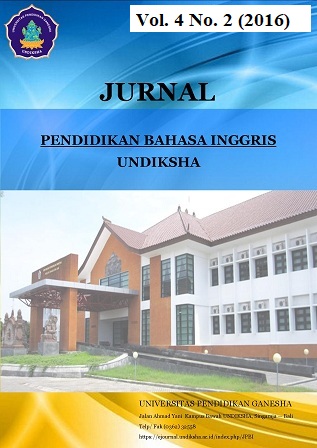AN ANALYSIS OF THE PRONUNCIATION ERRORS BY THE 11th GRADE STUDENTS OF SMKN 1 SUKASADA IN ENGLISH TEACHING AND LEARNING ACTIVITIES IN ACADEMIC YEAR 2015/2016
DOI:
https://doi.org/10.23887/jpbi.v4i2.8594Abstract
Tujuan penilitian ini adalah untuk menganalisis kesalahan-kesalahan pengucapan pada kata-kata bahasa Inggris dan penyebab-penyebab terjadinya kesalahan yang dilakukan oleh oleh siswa kelas sebelas SMK Negeri 1 Sukasada. Desain yang digunakan dalam penelitian ini adalah penelitian deskriptif kualitatif. Subyek dalam penelitian ini adalah siswa kelas sebelas Akomodasi Perhotelan SMK Negeri 1 Sukasada tahun ajaran 2015/2016 yang terdiri dari 30 orang siswa. Dalam mengumpulkan data, peneliti menggunakan perekam suara dalam membaca nyaring dan wawancara. Kemudian, data dianalisis melalui prosedur analisis kesalahan yang terdiri dari mentranskrip seluruh data yang direkam, menganalisis kesalahan siswa, mengklasifikasikan kesalahan, menghitung kesalahan, menjelaskan kesalahan berdasarkan sumber. Hasil analisis data menunjukkan bahwa kesalahan yang dilakukan oleh siswa telah diklasifikasikan ke dalam konsonan, vokal, dan vokal rangkap. Peneliti menemukan 564 total kesalahan, yang terdiri dari 167 atau 29.60% kesalahan pada konsonan, 262 atau 46.50% kesalahan pada vokal, dan 135 atau 23.90% kesalahan pada vokal rangkap. Kesalahan pada vokal adalah kesalahan yang sering dilakukan oleh siswa. Penyebab kesalahan yang dilakukan siswa adalah kesalahan intralingual dimana kesalahan disebabkan oleh telusuran didalam target bahasa (inggris), interlingual dimana kesalahan disebabkan oleh efek dari bahasa ibu dan kesalahan latihan dimana kesalahan adalah hasil dari kesalahan mengajar.Kata Kunci : kesalahan pengucapan, analisis kesalahan, sumber kesalahan.
The aim of this research is to analyze the pronunciation errors in English words and the sources of errors made by the students at the eleventh grade of SMK Negeri 1 Sukasada. The research design used in this study was descriptive qualitative research. The subjects of this research were the students at eleventh grade Akomodasi Perhotelan of SMK Negeri 1 Sukasada in academic year 2015/2016 that consisted of 30 students. In collecting the data, the researcher used recorder in reading aloud and interview. Then, the data were analyzed through error analysis procedure which consists of transcribing all data recorded, analyzing students’ errors, classifying the errors, evaluating the errors, explaining the errors based on the sources. The result of the data analysis shows that the errors made by the students were classified into consonant, vowel, and diphthongs. The researcher found 564 total errors, consisting of 167 or 29.60% errors in consonant, 262 or 46.50% errors in vowel, and 135 or 23.90% errors in diphthongs. Error in vowel is the most frequent errors made by the students. The sources of the errors made by the students are intralingual errors which were caused by the traced back to the target language (English), interlingual errors which were caused by the effect of the first language, and training errors which were the error that the result of wrong teaching techniques.
keyword : error pronunciation, error analysis, source of error.
Published
2016-10-31
Issue
Section
Articles
License
Authors who publish with the Jurnal Pendidikan Bahasa Inggris Undiksha agree to the following terms:- Authors retain copyright and grant the journal the right of first publication with the work simultaneously licensed under a Creative Commons Attribution License (CC BY-SA 4.0) that allows others to share the work with an acknowledgment of the work's authorship and initial publication in this journal
- Authors are able to enter into separate, additional contractual arrangements for the non-exclusive distribution of the journal's published version of the work (e.g., post it to an institutional repository or publish it in a book), with an acknowledgment of its initial publication in this journal.
- Authors are permitted and encouraged to post their work online (e.g., in institutional repositories or on their website) prior to and during the submission process, as it can lead to productive exchanges, as well as earlier and greater citation of published work. (See The Effect of Open Access)













